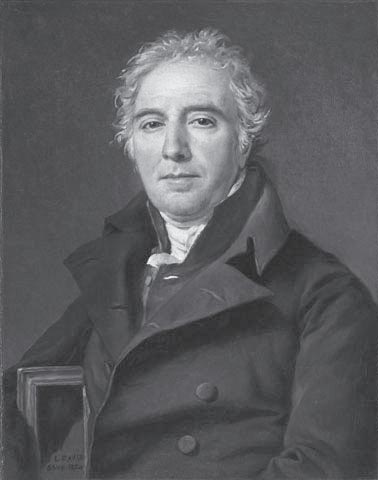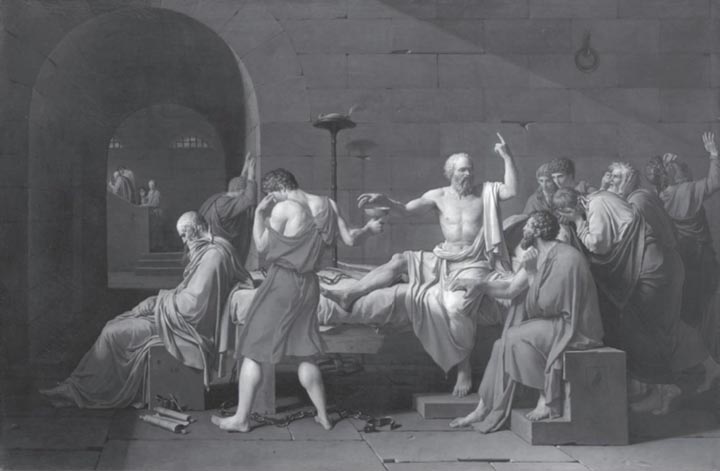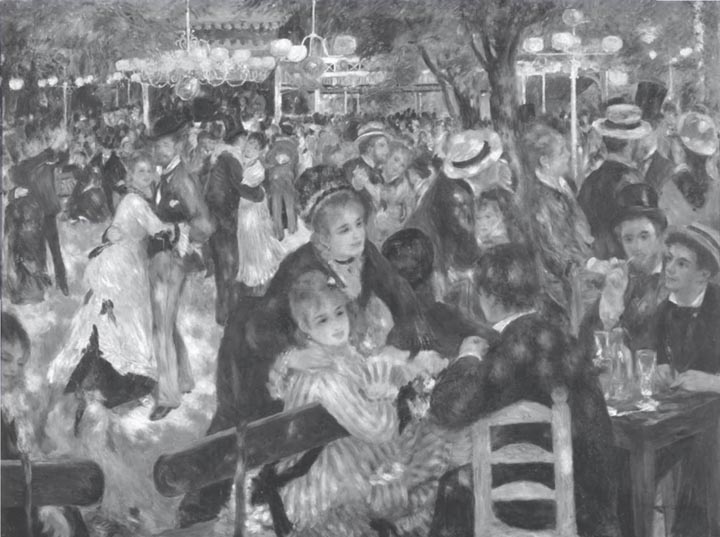





The end of the 18th century and the 19th century have witnessed a lot of monumental events that were decisive to the evolution of the modern world. The declining feudalism and monarchy were overthrown by capitalist revolution, first starting in France in its 1789 Revolution. The Enlightenment Movement had popularized ideas of human rights, equality, and democracy, which also helped the United States gain independence. Meanwhile, the Industrial revolution began to disintegrate the old social structure and build a new one upon its debris, freeing people's minds while setting individuals further apart. Against the vicissitude of the society, art was undergoing multi-faceted changes too. It had chemical reaction with the society, politics, nature and individuals brings forth a variety of schools including Neoclassicism, Romanticism, Impressionism, to name but a few.
18世纪末到19世纪是多事之秋,欧洲封建制和君主制开始衰朽,在启蒙运动的浪潮中,天赋人权、自由平等的思想开始深入人心,法国大革命是资产阶级的胜利,但是皇室的屡次复辟让民主革命的道路充满波折。而自由的思想也传播到了美国,帮助它赢得了独立战争。与此同时,工业革命使得社会逐步工业化,人们的世界观得到极大解放的同时,人与人之间的关系变得疏离。在这样风起云涌的社会背景下,艺术也发生了多次革新,艺术与社会、政治、自然、个体的关系发生着巧妙的化学变化,诞生如新古典主义、浪漫主义、印象主义等等流派。

雅克-路易·大卫

Neoclassicism is the name given to Western movements in the decorative and visual arts, literature, theatre, music, and architecture that draw inspiration from the "classical" art and culture of Ancient Greece or Ancient Rome. The main Neoclassical movement coincided with the 18th century Age of Enlightenment, and continued into the early 19th century.
Neoclassicism emphasized rationality and the resurgence of tradition. The towering art of ancient Rome and Greece was revived in the 18th century and this attempt was an opposition to the ostentatious Baroque and Rococo art that preceded the movement.Neoclassical artists were meticulous in their adaptation of Classical style and subjects. They drew their themes and models from the work of Homer's Illiad and Odyssey and Plutarch's books. Other classic models included Virgil, Raphael, and Poussin among others.
Neoclassicism was more than just a revival of the antiquities. It also represented the political events, and seriousness of the time. The movement coincided with the European Age of Enlightenment.Great minds of the time, including Voltaire, Rousseau, Montesquieu, Diderot, were advocating liberty, equality, human rights, and universal love.Feudalism and monarch were hanging in the balance and a great revolution was about to break out in France. In the build-up to the 1789 French Revolution, virtues and values traditionally associated to Ancient Rome such as heroism, stoicism or patriotism often became themes for paintings. Such style depicted society's rebellion against the lifestyle of nobility and the need of a democratic society. Therefore, Neoclassicism, entirely in keeping with the social trend, prospered in the era.
Neoclassical paintings were serious, unemotional, and sternly heroic.Neoclassical painters used sombre colours with occasional brilliant highlights, to convey moral narratives of self-denial and self-sacrifice fully in keeping with the supposed ethical superiority of Antiquity. They painstakingly depicted the costumes, settings, and details of classical subject matter with as much accuracy as possible. Many of the neoclassical painters integrated Greek and Roman elements into the portraits and paintings of their time, adding fabled beings, and mythological figures became quite common for this artistic period.

古典主义经典之作大卫的《荷拉斯兄弟之誓》


大卫的《苏格拉底之死》

The most distinguished Neoclassicist works are the paintings of JacquesLouis David. David was an active supporter of the French Revolution and aligned himself with Maximilien Robespierre and later Napoleon I. He drew parallelisms between the times of the Roman Republic and the struggle for liberty in France. The Oath of Horatii is one of the best known examples of David, considered to be the ideal of the new school of art. The painting portrays the Horatii brothers in ancient Rome swearing their allegiance to the state before they set off for the war while their father holds swords high for them to grasp. Their wives are crying on the side, suggesting the sacrifice of personal well-being for the good of the nation. His The Death of Socrates , he painted the philosopher as strong, calm and at peace when condemned to death, discussing the immortality of the soul with his grieving friends and students, Plato seated at the end of the bed in despair. In The Death of Marat , David depicted the death of the Jacobin Marat, also David's friend, after he was assassinated in his bathtub by a dissident in the disguise of a nurse. As the personal painter for the emperor, David painted a lot of portraits for Napoleon Ⅰ. His Coronation of Emperor Napoleon was renowned for its grandeur and details, where the artist chose the scene of the coronation of Queen Josephine as the motif.
新古典主义是西方重新发掘并弘扬古希腊和古罗马古典主义艺术的一种艺术流派,涵盖装饰和视觉艺术、文学、戏剧、音乐和建筑等方面,从18世纪中期开始,与启蒙运动同时发展起来,并持续到19世纪早期。
新古典主义崇尚理性和传统,古希腊和古罗马的宏伟艺术重新得到重视,反对之前盛行的浮华奢靡的巴洛克和洛可可艺术。这一时期的艺术家们从古典主义中汲取灵感,如荷马的史诗《伊利亚特》和《奥德赛》、古希腊传记作家普鲁塔克的作品,还有古罗马诗人维吉尔、文艺复兴时期画家拉斐尔和古典主义画家普桑等等。
出现这种思潮的原因,并不仅仅是怀古念旧而已,这与当时的政治背景是分不开的。当时的欧洲启蒙运动正如火如荼地开展,伏尔泰、卢梭、孟德斯鸠、狄德罗等思想进步的哲学家大力宣传自由、平等、人权、博爱等价值观,封建制度和皇室命悬一线,一场轰轰烈烈的大革命即将在法国爆发。在1789年革命正式爆发之前,古罗马所标榜的那种英雄主义、禁欲主义和爱国主义的精神成为绘画的主题,反对贵族、崇尚民主。因此,新古典主义就顺应时代潮流而生了。
新古典主义的主题严肃、直白,散发着强烈的英雄主义气息。新古典主义画家们使用肃穆的颜色,偶尔着以浓墨重彩,以强调古人崇尚的自我否定和自我牺牲精神,尽量忠实地还原当时的衣着、场景和其他细节。许多画家还借用古希腊和古罗马元素,如神仙鬼怪和传奇人物,来描绘当下的社会环境。
最具代表性的古典主义画家是雅克-路易·大卫。大卫与民主战士罗伯斯庇尔是朋友,罗伯斯庇尔死后,他开始支持拿破仑。他将罗马共和国与正在争取自由的法国做对比,其成名作《荷拉斯兄弟之誓》被视为新古典主义的经典之作。荷拉斯是古罗马的一个家族,大卫的作品描绘了荷拉斯三兄弟面对父亲举着的剑共同宣誓效忠国家奔赴战场的场景,他们的妻子在旁边哭泣,表示个人幸福应当服从国家利益的献身精神。他的《苏格拉底之死》,描绘了苏格拉底在喝下毒酒前从容镇定的状态,依然与悲痛欲绝的学生和朋友们谈论着永生和灵魂的问题,他的学生之一柏拉图哀伤地坐在床尾。《马拉之死》描绘了革命党人也是大卫朋友的马拉被伪装成护士的一名不同政见者杀死在浴缸里的情景。大卫也是拿破仑一世的御用画家,创作了许多拿破仑的肖像画,其巨幅作品《拿破仑加冕》以其精细的手法描绘众多的人物和恢弘的场面而闻名。

《拿破仑加冕》

Beginning in the late 18th century and lasting until the middle of the 19th century, a new Romantic attitude began to characterize culture and many art works in Western civilization. It started as an artistic and intellectual movement that emphasized a revulsion against established values (social order and religion). Instead Romanticism exalted individualism, subjectivism, irrationalism, imagination, emotions and nature, it valued emotion over reason and senses over intellect. These artists and philosophers of the time favored the revival of potentially unlimited number of artistic styles (basically anything that aroused their senses or imagination).
On the one hand, Romanticists combined reality and imagination to reenact current historic events to reflect their own attitude, particularly to revolt against the reviving monarchy and foreign aggression. For instance, Liberty Leading the People was a painting by Eugène Delacroix commemorating the July Revolution of 1830, which toppled Charles X of France. A woman personifying Liberty leaded the people forward over the bodies of the fallen, holding the tricouleur flag in one hand and brandishing a bayonetted musket with the other. The symbolism at work here is a major characteristic of romantic painting. What's more, Spanish artist Francisco de Goya commemorated Spanish resistance to Napoleon's armies during the occupation of 1808 in the Peninsular War in his The Third of May . And Théodore Géricault's Raft of the Medusa depicted the moment when the survivors came from the aftermath of the wreck of the French naval frigate Méduse called out for help as they saw ships on the horizon. Those who survived the 13 days drifting in the sea endured starvation, dehydration, cannibalism and madness, which were captured in Géricault's work.

反映1830年革命的《自由引导人民》

On the other hand, Romanticism was a revolt against aristocratic social and political norms of the Age of Enlightenment. The 1789 French Revolution was followed by the restoration of the Bourbon Dynasty. The disillusionment with the Enlightenment values of reason and order prompted artists to turn to nature and irrational things. Moreover, at that time Europe was undergoing the Industrial Revolution. The invention of the steam engine freed people from hard labor and broadened their minds. They started to question the current social order which was based on agriculture. The revolting nature of the Romanticism Movement was exactly what people needed.
In contrast to the usually very social art of the Enlightenment, Romantics were distrustful of the world of men, and tended to believe that a close connection with nature was mentally and morally healthy. Romantic works were eulogy to nature's uncontrollable power, unpredictability, and potential for cataclysmic extremes. The artists placed new emphasis on such emotions as apprehension, horror and terror, and awe—especially that which is experienced in confronting the sublimity of untamed nature and its picturesque qualities, both new aesthetic categories.
German Romantic landscape painter Caspar David Friedrich produced a great number of grandiose landscape paintings, such as The Wanderer above the Sea of Fog , The Cross Beside the Baltic, Moonrise over the sea , Graveyard under Snow , etc. His works are highly life-like, almost like photos to the naked eye. In the United States which had gained independence, the ode to nature as the Americans explored the land as an independent people was also in the rage. Thomas Cole's group painting The Voyage of Life puts the four stages of a person's life within the magnificence of nature.
浪漫主义起始于18世纪末期,一直到19世纪中期,最初反对现行社会制度和宗教制度,后来进化成强调个人主义、主观主义、非理性主义、想象、情感和自然的一种艺术风格,认为感性胜过理性,感觉胜过智力。当时的艺术家和哲学家探索了无数的创作形式,只要是能激发他们的感知和想象的都能为我所用。
一方面,浪漫主义艺术家通过现实和想象,来创作深刻反映当时的历史事件和他们的态度,尤其攻击复辟的君主制度和外来侵略。例如,法国画家欧仁·德拉克罗瓦最著名的作品《自由引导人民》就是歌颂推翻复辟的查理十世的七月革命的。画面上正中间的女性象征着自由,手中挥舞着法兰西革命的三色旗,另一只手握着装着刺刀的毛瑟枪,人们在她的领导下踏着战友的尸体向前冲锋。这里使用的象征手法是浪漫主义的一大特点。另外,西班牙著名画家弗朗西斯科·德·戈雅为纪念马德里人民奋起抵抗拿破仑1808年的侵略,创作的《五月三日》,也是反映历史事件的浪漫主义作品。而法国画家西奥多·杰里柯的《梅杜萨之筏》,取材于法国远航舰“梅杜萨号”触礁沉没事件,筏上残生者在望见远处船影时嘶声呼救的情景。这些在海上漂浮了13天的幸存者饥饿难耐,严重缺水,几近疯狂,都展现在杰里柯的作品中。
另一方面,浪漫主义也是作为一种反对启蒙运动中的社会政治制度而诞生的。1789年法国大革命后,换来的却是波旁王朝的复辟,令大批革命人士和知识分子失望不已。这种幻灭的情绪导致人们转向自然和非理性的东西。此外,当时欧洲正值工业革命,蒸汽机的发明使人们从繁重的劳动中解脱出来,极大地解放了人们的思想,人们开始怀疑建立在农业基础上的现行社会制度,浪漫主义运动的反抗特性正符合这种诉求。

《梅杜萨之筏》

它与启蒙运动中倡导的理性和社会秩序南辕北辙。启蒙运动中的艺术作品往往是为了服务于思想革命的需求,而浪漫主义绘画却表现出对人类世界的不信任,转而探寻自然,认为自然对人的身体和心灵都有裨益。浪漫主义作品讴歌自然的不受控制的变化、变幻莫测和翻手为云覆手为雨的力量,着重展现惊恐、畏惧、敬畏这样的情绪,尤其是至高无上的大自然和其令人叹为观止的美景所激发的感受。
德国浪漫主义风景画家卡斯帕·大卫·弗里德里希画了很多壮美的自然景色,如《雾海上的游荡者》、《波罗的海十字架》、《海上升明月》、《墓地的雪》等等。他的画作非常逼真,几乎有照片的效果。而在赢得了独立战争的美国,随着人们独立自主地开发自己的家园,对自然的崇敬之情也体现在绘画作品中。著名美国浪漫主义画家托马斯·科尔的组画《生命之旅》由四幅画组成——把童年、少年、成年和老年四个阶段放在雄伟的大自然背景之中,表现了对造物主所创造的自然的无比崇敬。
Impressionism was a late-19th-century French school that was generally characterized by the attempt to depict transitory visual impressions, often painted directly from nature, and by the use of pure, broken color to achieve brilliance and luminosity. Instead of painting the ideal beauty that earlier artists had defined, the impressionists tried to depict what they saw at a given moment, capturing a fresh, original vision. They often painted outdoors rather than in a studio so that they could observe nature more directly and seize the fast fleeing aspects, especially the changing light of the sun.
The movement began with the friendship of Monet, Renoir, Sisley, and Bazille, who were four students of the same teacher. They repudiated academic standards and reacted against the romantics' emphasis on emotion as subject matter. They forsook literary and anecdotal subjects and rejected the role of imagination in the creation of works of art. Instead they observed nature closely, with a scientific interest in visual phenomena.
Impression Sunrise Claude Monet, 1872, gave rise to the name "impressionism" which first appeared in the critique of the work.The painting captures the sunrise and the reflection in the sea and blankets the whole scene in a blur, for which it was first ridiculed. Monet and other pioneer impressionists used innovative techniques such as relatively small, thin, yet visible brush strokes, emphasis on accurate depiction of light in its changing qualities, and common, ordinary subject matter. Monet's Rouen Cathedral series captures the façade of the cathedral at different times of the day and year, and reflects changes in its appearance under different lighting conditions. Renoir, in characteristic Impressionist style and his distinct fondness on female sensuality, suggested the details of a scene through freely brushed touches of colour, so that his figures softly fuse with one another and their surroundings. Such style could be seen in his Dance at Le Moulin de la Galette, The Swing, The Theatre Box , etc.

《日出印象》

In late 19th century, a new style derived from Impressionism came into being called Neo-Impressionism. Georges Seurat's greatest masterpiece, A Sunday Afternoon on the Island of La Grande Jatte , marked the beginning of this movement. He invented Pointillism, a method consisting of placing tiny dots of pure colour paint which would be blended by the eye as opposed to being mixed on the palette. This method produced vibrant effects of colour.The technique's details can be clearly seen at a closer look, for instance in Seurat's The Circus .
印象派是19世纪晚期在法国兴起的一种艺术风格,强调捕捉转瞬即逝的印象,常以自然为主题,色彩纯正、用色断断续续,形成明烈而幻化的效果。印象派画家一改前人忠实于原物的传统,而抓取一个稍纵即逝的瞬间在头脑里留下的独一无二的印象。印象派画家走出小楼,在露天的环境里写生,这样他们得到的印象更直观,也能更敏捷地抓住白驹过隙的一瞬,尤其是光线的变化。
印象派是由师出同门的四位画家莫奈、雷诺阿、西斯莱和巴齐依开始的。他们推翻学院派的正统规则,不喜欢像浪漫派那样强调主观情绪。他们抛弃了文学和历史题材,也不提倡发挥主观想象,而是近距离地观察自然,以科学的态度去分析自然。
莫奈创立1872年的名画《日出印象》问世后,报纸上有人用“印象派”来评论这种新生的风格,印象派由此得名。莫奈画的是海上日出还有太阳在水中波动细碎的倒影,整幅画笼罩在迷蒙之中,人们开始并不接受这种前卫的风格,对它大加批判。以莫奈为代表的印象派先锋们使用浅淡的颜色、短促有力的笔法,强调对光线的准确描绘,还有随着时间流逝光的各种变化,主题都是普通的人和事物。莫奈的另一幅名作《鲁昂大教堂》,画了一天中不同时候鲁昂大教堂的面貌,可见其探索色彩和光线的匠心独运。另一位印象派大师雷诺阿画了很多女性为主题的画,色彩铺陈,人和物似乎要与背景融合在一起,在他的《红磨坊的舞会》、《秋千》、《包厢》等鲜明地体现了这种风格。

《红磨坊街的舞会》

19世纪末期,一种新的印象流派诞生,叫做新印象派,以乔治·修拉的名作《大碗岛的星期天下午》最为著名。修拉使用了一种新的绘画方式:点彩法,就是用纯色涂上一个一个的小点,最后构成一幅画,这样画出来的画色彩特别集中而明丽。点彩法的细节可以通过放大作品来观赏,如修拉的另一幅名作《马戏团演出》。